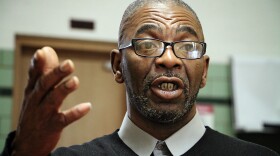We use the "gap" metaphor a lot. The opportunity gap. The discipline gap. The achievement gap. Well, now we've got another one to add to the list: the adventure gap, where minorities, especially those in inner cities, are much less likely than their white peers to experience the outdoors – especially state and national parks.
A recent New York Times article put the gap into hard numbers:
The national parks attracted a record 292.8 million visitors in 2014, but a vast majority were white and aging. The most recent survey commissioned by the park service on visitation, released in 2011, found that 22 percent of visitors were minorities, though they make up some 37 percent of the population.
But there’s an effort underway to shrink that gap for youth in Detroit.
Linda Walter is with the Michigan Department of Natural Resources and the director of the brand new Outdoor Adventure Center in the heart of Detroit. She says in a lot of urban areas like Detroit, "people haven't taken their families hunting, camping, or fishing," which Walter says is a problem, because if you're never exposed to those things, how will you know if you'd even like it?
That's where the Outdoor Adventure Center comes in. "Here," says Walter, "we're going to show you could like it, and then we're going to show how you do it, and then we're going to tell you where you can do it."

The center officially opened to the public this week. It's housed in a big old renovated warehouse, in a prime location right on the Detroit Riverwalk. Inside, visitors get a taste of what they could find at various state parks around Michigan. There’s a giant aquarium filled with native fish, a 38-foot waterfall, a suspension bridge three stories high. All of it is set against a backdrop of piped in wildlife sounds.
You can learn how to kayak, fish, hunt, and ride a snowmobile. See what it’d feel like to camp in a tent or a yurt. The archery room wasn't open to the public on opening day, but should be soon. There's also a manmade 40-foot oak tree that you can climb in and on and up and down. That's where Terrie Hobbs spent most of the afternoon with her 3-year-old son and teenage daughter.
Hobbs says she’s never had the chance to take her family up north, but she’d love to go. Before she visited the center, she thought there wasn't much to do up north but ski, and Hobbs says they're "not skiing people, not water-skiing people." But now she sees that there are lots of other things to do up north, like fish and hike and camp. She hopes that she and her children will one day "be able to go up there and they can say 'oh, [we] recognize these things!'" That, she says, would be great.

To help families like the Hobbs feel comfortable exploring the great outdoors, the Outdoor Adventure Center plans to offer classes for kids and adults in an effort to bridge the adventure gap. Another way the city is trying to get more kids outdoors is through the National Park Service's Urban Fellows program. Detroit is one of ten cities selected for the program. David Goldstein is Detroit's newly minted urban fellow. He recently moved to the city and will be here for two years, working on ways to connect with and inform residents about recreation activities and stewardship.
Now, if you think this "gap" only affects inner city kids, you're wrong.
James Mills is a Wisconsin-based journalist and author of The Adventure Gap: Changing the Face of the Outdoors. He says if people of color continue to "spend less time in nature than their white counterparts, when that population becomes the majority population, that means a majority of people in this country will have no affinity for nature."
And that could seriously impact efforts to preserve and conserve wild and scenic places for the next generation to discover and explore.
CORRECTION: The original post said there will soon be a rock climbing wall and an archery room at the Center. There is only an archery room. The post has been updated to reflect that.






